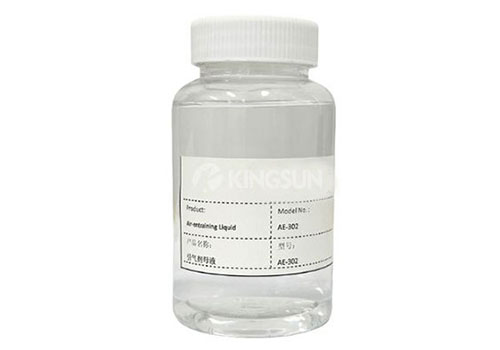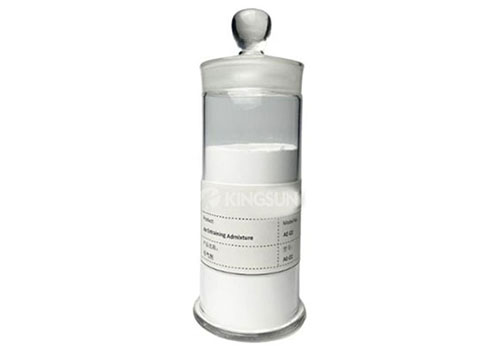Air-entraining agent is a hydrophobic surfactant that is dissolved in water and added to the concrete mixture. It can produce a large number of tiny bubbles during the mixing process. The main types of air-entraining agents include rosin resins, alkyl and alkyl aromatic sulfonic acids, fatty alcohol sulfonates, saponins, protein salts, petroleum sulfonic acid, etc. The commonly used dosage is 50-500ppm of the weight of cement. Air-entraining agents are mainly used for structures with high requirements for frost resistance, such as concrete dams, roads, bridge decks, airport pavements and other large areas that are susceptible to freezing.
Air-entraining agents can improve the fluidity, cohesion and water retention of concrete mixtures and improve the fluidity of concrete. In the mixing process of concrete mixtures, a large number of evenly distributed, closed and stable tiny bubbles are introduced into the admixture, thereby improving the durability and working performance of concrete.
Air-entraining Agent for Sale in Our Company
It is an anionic surfactant whose interfacial activity mainly occurs at the gas-liquid interface, which can significantly reduce the surface tension and interfacial energy of water. The air-entraining agent molecules are directional adsorbed on the surface of the bubbles, making it easy for the aqueous solution to form many fine closed liquid films with a diameter of less than 200μm during the stirring process, giving the material excellent working performance. In addition, it also has the performance of anti-freeze, anti-seepage, and sulfate erosion resistance, thereby improving the durability of the material.
| Detection Index | AE-302 | AE-02 |
| Appearance | Transparent to light yellow liquid | White to light yellow powder |
| Bulk density (g/l) | 1-1.2 | 400-600 |
| Active ingredients (%) | 28 | 99 |
| Dosage | Should be added at a minimal dosage of 0.001% to 0.3% by total weight of components. The actual dosage should be determined through suitable tests prior to production and application. | |
| Storage | Under condition 5-35°C, dry and cool. Prevent direct sunlight, moisture and be pressed for caking. | |
| Packaging | 200kg/drum, 1000kg/ IBC tank | 25kg paper bag |
Excellent Performance of Air-entraining Agent
Excellent freeze-thaw resistance
Enables concrete to withstand more than 100 freeze-thaw cycles without damage in extreme environments of -30℃~50℃. The bubble structure buffers the expansion pressure of ice crystals and reduces the risk of internal microcracks.
Significantly improve workability
The “ball effect” of bubbles reduces aggregate friction, increases slump by 10%~20%, and reduces pumping resistance by more than 15%.
Effectively inhibits water seepage and segregation, especially suitable for high-strength concrete with low water-cement ratio.
Enhance impermeability and chemical durability
Bubbles block capillary channels, and the chloride ion diffusion coefficient is reduced by 30%~50%.
The ability to resist sulfate corrosion is increased by more than 2 times.
Reduce plastic shrinkage cracks
The surface moisture evaporation rate is reduced by 25%~40%, effectively preventing early plastic cracking, and cracks are reduced by more than 50%.
After hardening, there is no honeycomb surface, which improves the apparent quality.
Balance of strength and durability
Under the optimized dosage (0.02%~0.05%), the 28-day compressive strength only decreases by 5%~10%, but the durability is increased by 3~5 times.
The strength loss can be completely compensated by compounding high-efficiency water reducer.
Environmental protection and economic advantages
Reducing cement consumption by 5%~8% and reducing CO₂emissions by improving workability.
Extending the structural maintenance cycle and reducing the life cycle cost by 20%~30%.
- Combined Uses with Other Concrete Additives
- Main Applications
- How Does It Work
Air entraining agent is usually not used alone in concrete, but is compounded with other admixtures to optimize the overall performance of concrete. A reasonable compounding scheme can enhance bubble stability, increase strength, improve durability, and avoid negative effects (such as strength loss).
Air entraining agent + Water Reducer (Sodium Naphthalene Sulfonate/Polycarboxylate Superplasticizer)
Improve workability. Water reducer reduces the water-cement ratio, and air entraining agent provides lubrication, making concrete easier to pump and vibrate.
Reduce strength loss. Water reducer compensates for the strength reduction caused by air entrainment (for every 1% increase in air content, the compressive strength decreases by 3~5%).
Optimize bubble structure. Polycarboxylate Superplasticizer can stabilize bubbles and prevent them from merging or breaking.
Air entraining agent + Retarder
Prolong bubble stability. Concrete retarder (like sodium gluconate) delays cement hydration to prevent bubbles from breaking due to too fast hardening of the slurry.
Improve summer construction performance. Concrete slump loss is fast at high temperature, and retarder + air entraining agent can maintain workability.
Air entraining agent + early strength agent
This combination can offset the adverse effect of air entraining agent on early strength.
Suitable for winter construction. Air entraining agent improves frost resistance, and early strength agent prevents frost damage.
Air entraining agent + Hydrophobic powder
Plays a dual role of anti-seepage protection.
Air entraining agent blocks capillary pores, and waterproofing agent forms a water repellent film on the pore wall, which can improve resistance to chloride ion permeability.
Cold area and freeze-thaw environment engineering
Concrete structure in cold areas. Freeze-thaw cycles can cause the internal water of concrete to freeze and expand, resulting in stress damage. Air entraining agent can provide buffer space and reduce frost heave pressure.
Deicing salt environment. Deicing salt (NaCl, CaCl₂) will accelerate the freeze-thaw damage of concrete, and air entraining agent can reduce salt crystallization pressure and chloride ion penetration.
Hydraulic and marine engineering
Dams, sluices, channels, etc. Frequent changes in water levels lead to freeze-thaw damage, and air entraining agents can improve frost resistance and impermeability. The air content is usually controlled at 4.5%~6.5%, and the bubble spacing coefficient is ≤250μm.
Marine engineering. Air-entraining agents can delay steel corrosion and concrete spalling due to the double damage of chloride ion erosion and freeze-thaw cycles in seawater.
Transportation infrastructure
Highway and airport pavement. Improve freeze-thaw resistance, reduce surface spalling, and improve anti-skid performance. The air content is usually 3%~5%, so as not to affect the strength too much.
Railway engineering. Air-entraining agents can be used in cement asphalt mortar to improve elasticity and fatigue resistance.
Special concrete engineering
Self-compacting concrete. Air-entraining agents can improve fluidity, reduce segregation and bleeding, and improve pumping performance. The air content is generally controlled at 2%~4%, so as not to affect the strength too much.
Lightweight concrete. Air-entraining agents can reduce the density of concrete and improve thermal insulation performance.
Industrial and civil buildings
High-rise buildings. Improve the fluidity of pumped concrete and reduce the risk of cracks.
Floors and wear-resistant floors. Air-entraining agents can reduce surface powdering and improve wear resistance.
Other special applications
Shotcrete. Improve pumpability and reduce rebound loss.
Decorative concrete. Improve surface finish and reduce air bubble defects.
3D printing concrete. Optimize rheological properties and improve printability.
Reduce surface tension. Air entraining agents are mostly anionic surfactants that can be directed to the air side at the water vapor interface, significantly reducing the surface tension of water. This effect of reducing surface tension makes it easy to produce many tiny closed bubbles during concrete mixing.
The bubbles are stable. Air entraining agent adsorbs with cement or its hydrated ions at the cement-water interface to form a hydrophobic layer. These bubbles repel each other due to the directional adsorption layer with the same charge, so they are evenly distributed and remain stable. In addition, some anionic air entraining agents will produce calcium salt precipitation in cement aqueous solution with high calcium content. These precipitates are adsorbed on the bubble membrane, effectively preventing the bubble from bursting.



